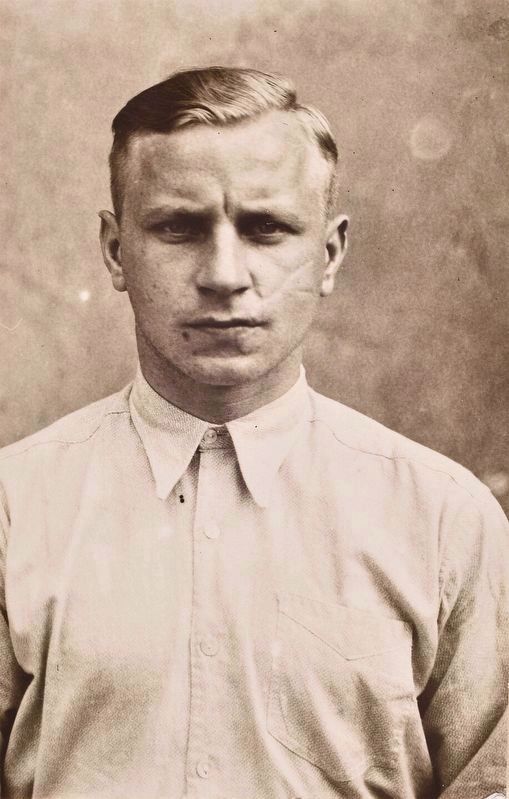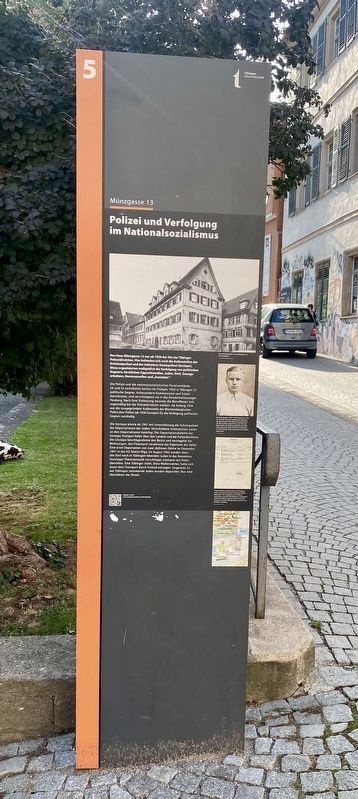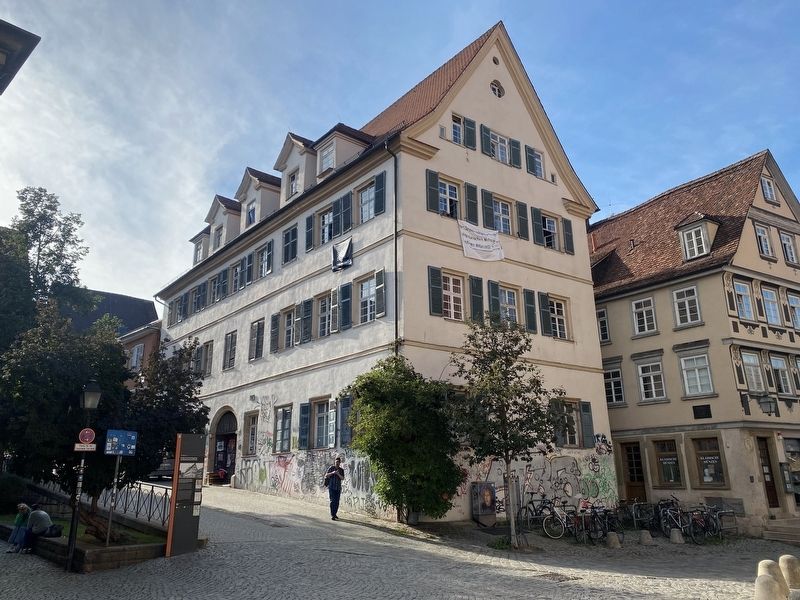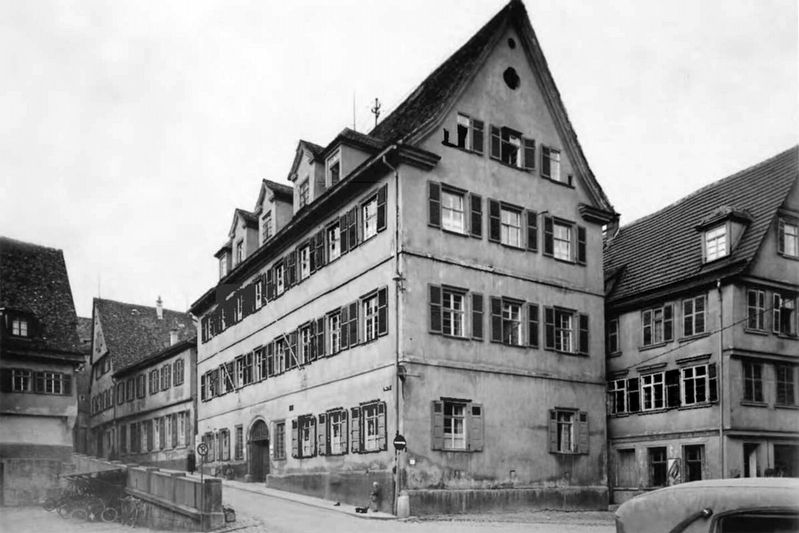Tübingen, Baden-Württemberg, Germany — Central Europe
Polizei und Verfolgung unter Nationalsozialismus / Police and Persecution under National Socialism
Münzgasse 13
— Geschichtspfad zum Nationalsozialismus —
Inscription.
Das Haus Münzgasse 13 war ab 1936 der Sitz der Tübinger Polizeidirektion. Hier befanden sich auch die Außenstellen der Kriminalpolizei und der Geheimen Staatspolizei (Gestapo). Diese organisierten maßgeblich die Verfolgung von politischen Gegnern, kirchlichen Oppositionellen, Juden, Sinti, Zwangsarbeitern, Homosexuellen und „Asozialen“.
Die Polizei und die nationalsozialistischen Parteiverbände SA und SS verhafteten bereits im Frühjahr 1933 in Tübingen 27 politische Gegner, insbesondere Kommunisten und Sozialdemokraten, und verschleppten sie in das Konzentrationslager Heuberg. Nach ihrer Entlassung mussten die Betroffenen sich regelmäßig bei der Polizeidirektion melden. Ab Anfang 1934 war die neugegründete Außenstelle der Württembergischen Politischen Polizei (ab 1936 Gestapo) für die Verfolgung politischer Gegner zuständig.
Die Gestapo plante ab 1941 mit Unterstützung der Schutzpolizei die Deportationen der Juden. Verschiedene Institutionen waren an den Deportationen beteiligt. Die Deportationsbefehle der Gestapo Stuttgart liefen über den Landrat und die Polizeidirektion. Die Gestapo beschlagnahmte den Besitz und versiegelte die Wohnungen, das Finanzamt verwertete das Eigentum der Opfer. Eine erste Deportation von zwei Jüdinnen führte im Dezember 1941 in das KZ-Ghetto Riga, im August 1942 wurden dann alle fünf noch in Tübingen lebenden Juden in das Konzentrationslager Theresienstadt verschleppt; niemand von ihnen überlebte. Eine Tübinger Jüdin, Klara Wallensteiner, hatte sich zuvor dem Transport durch Freitod entzogen. Insgesamt 22 aus Tübingen stammende Juden wurden deportiert. Nur zwei überlebten die Shoah.
From 1936 on, the Tübingen Polizeidirektion (police department) was based in Münzgasse 13. It also housed branches of the Kriminalpolizei (criminal police, KriPo) and the Geheime Staatspolizei (Secret State Police, Gestapo). These institutions were mainly responsible for organizing the persecution of political enemies, opponents from the Christian Churches, Jews, Sinti, forced laborers, homosexuals, and "Asoziale" (a derogative compound term for the "work-shy", the homeless, alcoholics, prostitutes, and others).
Beginning in early 1933, the police and the National Socialist organizations Sturmabteilung ("Storm Detachment" brown-shirt stormtroopers, SA) and Schutzstaffel ("Security Squadron", SS) arrested 27 political enemies in Tübingen, especially Communists and Social Democrats, and carted
them off to Heuberg concentration camp in the Swabian Jura. After their release, they had to regularly report to the police department. Starting in early 1934, the recently established branch of the Württemberg Politische Polizei (political police; part of the Gestapo from 1936 on) was responsible for the persecution of political enemies.
From 1941 on, the Gestapo, supported by the Schutzpolizei (uniformed police, SchuPo), planned the deportations of Jews. Various organizations were involved in the deportations. The orders were relayed from the Gestapo in Stuttgart to the Landrat (county administrator) and the police department. The Gestapo confiscated personal possessions and sealed the residences of deportees while the Finanzamt (tax and revenue office) sold the victims' property. On December 1, 1941, the first two Jewish women from Tübingen were deported to the concentration camp/ghetto in Riga, Latvia. In August 1942, the remaining five Jews were carted off from Tübingen to Theresienstadt concentration camp near Prague; none of them survived. One Jewish woman, Klara Wallensteiner, eluded deportation by committing suicide. In total, 22 Jews who came from Tübingen were deported. Only two survived the Shoah.
Erected 2016 by Geschichtswerkstatt Tübingen. (Marker Number 5.)
Topics and series. This historical marker
is listed in these topic lists: Law Enforcement • War, World II. In addition, it is included in the The Holocaust series list.
Location. 48° 31.193′ N, 9° 3.338′ E. Marker is in Tübingen, Baden-Württemberg. Marker is on Münzgasse, on the left when traveling west. Touch for map. Marker is at or near this postal address: Münzgasse 13, Tübingen BW 72070, Germany. Touch for directions.
Other nearby markers. At least 8 other markers are within walking distance of this marker. Alte Aula (a few steps from this marker); Martinianum: Keimzelle der Schwäbischen Romantik / Nucleus of Swabian Romanticism (a few steps from this marker); Nikodemus Frischlin (within shouting distance of this marker); Philipp Melanchthon (within shouting distance of this marker); Former Dominican Building (within shouting distance of this marker); Josef Eberle (Sebastian Blau) (within shouting distance of this marker); Tübingen Roma and Sinti Memorial (within shouting distance of this marker); Hermann Hesse (within shouting distance of this marker). Touch for a list and map of all markers in Tübingen.

Photographed By Bundesarchiv Berlin
4. Marker inset: Herbert Kappler
"Herbert Kappler (1907-1978) was the head of the Tübingen branch of the Geheime Staatspolizei (Secret State Police, Gestapo) from 1934 to 1938. As commander of the Sicherheitspolizei (Security Police, SiPo) and the Sicherheitsdienst (Security Service, SD) of the Schutzstaffel ("Security Squadron", SS) in Rome, he organized the deportation of the local Jewish population and, on March 24, 1944, the shooting of 335 hostages during the Adreatine massacre." - Geschichtswerkstatt Tübingen
Credits. This page was last revised on September 23, 2022. It was originally submitted on September 23, 2022, by Andrew Ruppenstein of Lamorinda, California. This page has been viewed 76 times since then and 11 times this year. Photos: 1, 2, 3, 4. submitted on September 23, 2022, by Andrew Ruppenstein of Lamorinda, California.


